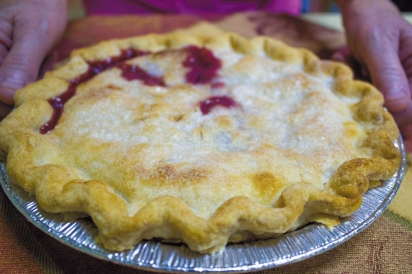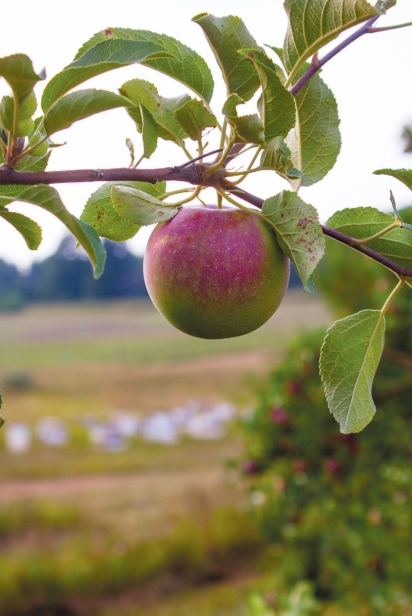Tending and Cultivating: Brown’s Poplar Ridge Orchard Organic Apples
We are bouncing along a two-track that runs between two different orchards in a large allterrain vehicle, three of us across the front seat, equipment and ladders and farming stuff on the back. Lauri Brown points out the apples that still are grown by Merle, her father-in-law, on our right. Their deep red color contrasts with the blue sky above and the hundreds of trees of green apples on the left, which are grown by Lauri and her husband, Bob. The green ones are Transparent apples, one of nearly 40 varieties whose trees grow in a hilly orchard not far from the shores of Lake Michigan, near Bear Lake.
Merle Brown bought the land in 1972 and now three generations—four, if you count the grandkids that come to help pick—of the Brown family work the 450-acre farm, raising not only apples, but also peaches, pears, apricots and at least two kinds of cherries. They also keep greenhouses, tap trees for maple syrup, and jar their own honey from the many hives that dot the rolling landscape that is Brown’s Farm. Merle still owns and works part of the farm, but his son Bob, 62 and wife. Lauri, 59, bought a chunk of it in 2008, and then took over most of it in 2014. Now Bob and Lauri’s son, Ted, 37, farms with them and has his own farm with dairy cows.
The vehicle comes to a stop and Bob gets out, and goes over to the latch of a huge gate, taller than he by many feet. After he moves the gate and climbs back in to drive us through it, he gets out and closes it carefully again. When we come to nearly the middle of acres and acres of heavily laden fruit trees and he turns off the engine, he explains the tall fences.
“These fences are huge and expensive—this one encloses about 250 acres—but they pay for themselves in about a year. The deer eat so much of our crop if we don’t. See these low-hanging branches? We never had any of these before the fences went up—they damaged the trees and they ate everything to right about here,” as he points to a branch up over his head.
The low-hanging branches are covered in bunches of pink and green apples, blushing in the evening sun to a color that is hard to describe in its beauty. The apples are uniform and succulent, with very few blemishes. We are walking between the rows of apples on lanes that are mowed by tractor, but under the trees themselves is grass about knee high. Lauri points out the many beehives nestled into a hillside at the edge of the orchard, and I walk through some tall grass to get a good photo of them.
“The grass under the trees is how you can tell this is an organic orchard,” Bob tells me. “In a conventional orchard the chemicals kill even the grass under the trees, so they look more neat and tidy. The messy grass in the rows is actually a good thing,” he grins.
He goes on to tell me about the vastly complicated processes that rule organic agriculture and the overwhelming paperwork that goes with it. He also tells me about the spray schedule he uses to combat fungus, disease and insects. Organic apples actually get sprayed more often than conventional apples, and rain forcasting is critical. It is an ever-changing science experiment to plan for the weather and pest cycles every growing season. In the end, organic apples might look different than those heavily sprayed with conventional pesticides.
“That means there are marks on some apples. Not everybody likes that, some people want perfect apples,” says Lauri Brown, referring to her retail customers, some who pass by the organic apples because they have small blemishes. “But they are missing the point.”
The point is why Merle Brown went organic in the first place, back in 1996. There were market trends that pointed toward a good future for organic apples, but he was primarily motivated by the health concerns of chemical-intensive orcharding. He was nearly 25 years into farming his orchard the conventional way, and it took him three years and mountains of paperwork to change over to organic. That commitment is still there, passed down to his family, along with the work ethic that it takes to run a big farm operation.
Bob tells me that he has not had a real vacation in many years, and despite the fact that he lives near one of the most beautiful lakeshores in the world, his feet have not been on a beach for decades. He just does not have time. The management details, including knowing the names and schedules of all their many fruits, are all in Bob’s brain, not on some spreadsheet on a computer. He and Lauri do a lot of the picking for market so they can be sure the very best apples go to the customers they know. They also have some migrant workers who live with them for the harvest, but there are fewer and fewer of those kind of laborers available to help these days.
The burden of all the work seems overwhelming at time, he admits.
“The cost of the organic sprays has gone up significantly in the last couple of years—one component of them I really need has gone up $100 per quart! Yet the prices we get for our apples has not. Our processors, who buy all the apples that we don’t take to market, have not increased their payout at all. Plus, the market for organic in the general population is not increasing right now.”
The squeeze of the ever-shrinking profit in farming causes him and Lauri a lot of stress.
“Thank goodness for the markets,” she says.
PIES, LOTS AND LOTS OF PIES
Lauri Brown is referring to the five farmers markets she is part of each week. She takes crates of fresh fruit, along with vegetables, honey, maple syrup and baked goods to Interlochen, Elberta, Onekama, the Sara Hardy Saturday market and to Grow Benzie. This, too, seems like an incredible amount of work.
“During the six busiest weeks of the summer, I bake about 150 pies, plus 200 muffins, granola, bars, breads, and coffee cakes. I bake a full two days a week to keep up with it, and sometimes at night between markets. My sister comes and helps me, and Bob will do the filling with me if I have a lot to do.”
I am sure I looked incredulous. Pie crusts for 150 pies? By hand? Each week?
“It does not matter if you are making one or 60, you have the same mess to clean up,” she winks.
Later, when we walk into the commercial kitchen up near the house, I am stunned by how small it is, and how well organized. A huge mixer sits near a window, and a long counter comes out into the small space, dividing the mixing area from the baking area, the huge oven that will hold 24 pies at a time. There is only one sink. A storage area behind the kitchen holds stacks and stacks of bins containing all the product that will go to a market the next day.
Lauri makes all the products from scratch, including the piecrusts.
“It’s the crust that sells the pie. I use vegetable shortening and the same recipe I have used for years. I usually make the crusts the same day, but sometimes I will make and roll out a bunch of bottoms and freeze them.”
She shows me a cherry pie, their most popular, she says, because of where we live and the pride Michiganders have in their cherries. Mixed-fruit pies have become very popular, too, so she makes strawberry rhubarb, peach rhubarb and raspberry rhubarb pies as well. The crust is beautiful, flaky and baked perfectly, uniformly crimped around the edges by the hardworking hands in front of me.
Lauri gets a lot of special orders, both by phone or by customers making requests at a market. She often provides pies for non-traditional weddings and states that pies are now a trendy offering instead of cake, or at least another option on a bridal table. She can make many accomodations for people on special diets, and she encourages customers to ask for custom orders.
Oryana and Children’s House in Traverse City also get deliveries of fruit each week, and that has to be figured into her busy schedule.
GOODNESS
Bob stops the ATV one more time. He rummages around in the back of the vehicle and comes out with two tubes of pheromones. He puts part of the tube onto the sticky surface of a thick piece of graph paper. He puts the sticky paper into a orange tent-like bug trap that hangs from one of the trees. As we begin the drive back to the main farm, I notice many more of the orange tents, all placed by hand, all monitored personally by the farmer as he goes about his daily work.
The couple discuss some of the chores left to do that night, and briefly review some plans for the next day, and they seem happy, if a bit weary, as the work of late summer brings them to the busiest time of their year.
Why do they do all of this, day in and day out, year after year, with very little break?
Bob nods to Lauri, indicating that she should take this question.
She sighs, then explains her concerns. They love their work, but question the sustainability of such a large operation as she and Bob get older, and no young people are clamoring to take their place.
“One of our daughters became a pharmacist— a different kind of ‘pharm,’” she jokes, but I can tell that it all worries her, the workload, the never-ending schedule of things to do, the slim margin of profit they manage to eke out. Her quiet good humor belies her struggle to see a future where an organic farmer can actually succeed over the course of many years.
“We would not be doing this if we did not think it was important,” adds Bob.
Lauri goes on. “I see the families come to my table at the market and they are choosing us because they believe in what we are doing, and they want to feel good about what they feed their kids. That means that what we are doing has an impact, and it drives people to choose to eat and cook with our products.”
She flashes a big smile.
“That keeps them coming back ... well, that and the pies.”
Brown’s Poplar Ridge Farm
11317 Erdman Rd, Onekama
Find them at the markets: Interlochen, Elberta, Onekama, Traverse City Sara Hardy (Saturdays) and Grow Benzie
For special orders contact 231-889-3513












